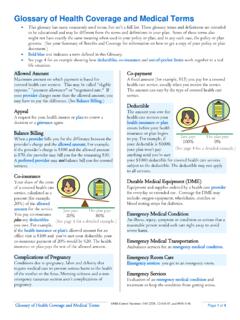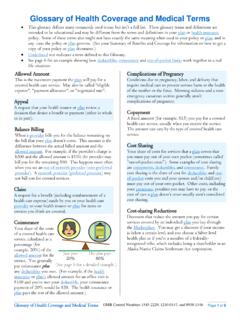Transcription of Health Promotion Glossary - World Health Organization
1 World Health OrganizationGenevaHealth Promotion GlossaryWHO/HPR/ : Limited World Health Organization 1998 The views expressed in this document by named authors are solely the responsibility of these document is not issued to the general public and all rights are reserved by the World Health Organization (WHO).The document may not be reviewed, abstracted, quoted, reproduced, translated, in part or in whole, without the priorwritten permission of WHO. No part of this document may be stored in a retrieval system or transmitted in any form orby any means electronic, mechanical or other without the prior written permission of of Health Promotion , Education and Communications (HPR) Health Education and Health Promotion Unit (HEP)WHO/HPR/ : LimitedDesign: Marilyn LangfeldPrinted in Switzerland on recycled paper, 4 000 Promotion GlossaryWorld Health OrganizationGeneva iiThis Health Promotion Glossary was prepared on behalf of WHO by DonNutbeam, WHO Collaborating Centre for Health Promotion ,Department of Public Health and Community Medicine, University ofSydney, Australia.
2 A pre-publication of the Glossary was prepared as a resourcedocument for the Fourth International Conference on Health Promotion , NewPlayers for a New Era: Leading Health Promotion into the 21st Century, Jakarta,Indonesia, 21-25 July 1997. The pre-publication was subsequently revised toaccount for the outcomes from that Conference, specifically the JakartaDeclaration on Leading Health Promotion into the 21st thanks are due to Ursel Broesskamp-Stone for her support, advice,technical contributions and perseverance, and to Desmond O Byrne for hisinput and advice in the preparation of the Glossary , both of the HealthEducation and Health Promotion Unit, WHO, Geneva; to Ilona Kickbusch forher expert opinion and guidance throughout the process of preparation andrevision of the Glossary , Division of Health Promotion , Education andCommunication, WHO, Geneva; and to the Regional Advisors for HealthPromotion/ Health Education of the WHO Regional Offices for co-ordination ofthe review of the early drafts and helpful suggestions.
3 Iii Contents Foreword: Moving towards a new public healthv Introductionvi Notesvii Health Promotion Glossary Section I: List of Basic Terms1 Health1 Health promotion1 Health for All2 Public health3 Primary Health care3 Disease prevention4 Health education4 Health Promotion Glossary Section II: Extended List of Terms5 Advocacy for health5 Alliance5 Community5 Community action for health6 Determinants of health6 Empowerment for health6 Enabling7 Epidemiology7 Equity in health7 Health behaviour8 Health communication8 Health development8 Health expectancy9 Health gain9 Health goal9 Health indicator9 Health literacy10 Health outcomes10 Health policy10 Health promoting hospitals11 Health promoting schools11 Health Promotion evaluation12 Health Promotion outcomes12 Health sector12 Health status12 Health target13 Healthy cities13 Healthy islands13 Healthy public policy13 Infrastructure for Health promotion14 Intermediate Health outcomes14 Intersectoral collaboration14 Investment for health15 Jakarta Declaration on Leading HealthPromotion into the 21st Century15 Life skills15 Lifestyle (lifestyles conducive to Health )
4 16 Living conditions16 Mediation16 Network16 Ottawa Charter for Health Promotion17 Partnership for Health promotion17 Personal skills17 Quality of life17Re-orienting Health services18 Risk behaviour18 Risk factor18 Self help19 Settings for health19 Social capital19 Social networks19 Social responsibility for health20 Social support20 Supportive environments for health20 Sustainable development20 References23 iv vForeword: Moving towards a new public healthThe first edition of this Health Promotion Glossary of terms was published by WHO in 1986 as aguide to readers of WHO documents and publications. It met a useful purpose in clarifying themeaning and relationship between the many terms which were not in common usage at thattime. This first edition of the Glossary has been translated into several languages (French, Spanish,Russian, Japanese and Italian), and the terms defined have been widely used both within andoutside WHO.
5 The Glossary was adapted and republished in German in has happened since the publication of the Glossary a decade ago. Most notably, in October1986 the First International Conference on Health Promotion was held in Ottawa, Canada,producing what is now widely known as the Ottawa Charter for Health Promotion . Thisconference was followed by others which explored the major themes of the Ottawa Charteron healthy public policy (in Adelaide, 1988), and on supportive environments for Health (inSundsvall, 1991). These conferences have added greatly to our understanding of healthpromotion strategies and their practical application, as well as more fully accounting for issuesof relevance to developing countries. This was taken a step further at the Fourth InternationalConference on Health Promotion , New Players for a New Era: Leading Health Promotion into the21st Century, which was held in Jakarta, Indonesia, in July WHO programmes and projects have been developed and implemented which havesought to translate Health Promotion concepts and strategies into practical action.
6 These includethe Healthy Cities, Villages, Municipalities and Healthy Islands projects, the networks ofHealth Promoting Schools and Health Promoting Hospitals, and the Healthy Marketplacesand Health Promoting Workplaces projects, as well as WHO action plans on alcohol andtobacco, active living and healthy developments in Health systems around the World have given new prominence to healthpromotion approaches. The increasing focus on Health outcomes reconfirms the priority placedon investment in the determinants of Health through Health Promotion . Continually askingthe question where is Health created? links Health Promotion to two major reform debates:the formulation of new public Health strategies, and the need to re-orient Health services. Theforesight shown in the Ottawa Charter has been adopted by many countries and organizationsaround the World a process which was taken one step further through the Fourth InternationalConference on Health Promotion in Jakarta, July 1997.
7 This conference adopted the JakartaDeclaration on Leading Health Promotion into the 21st Century. A number of terms that arecentral to the Jakarta Declaration have therefore been included in this new version of thehealth Promotion KickbuschDirectorDivision of Health Promotion , Education andCommunicationWorld Health Organization , GenevaJanuary 1998 vi IntroductionWith a decade of experience, and continued evolution and development of ideas since theproduction of the first Glossary , this revision provides an updated overview of the many ideasand concepts which are central to contemporary Health Promotion . This time, as previously,the basic aim of the Glossary is to facilitate communication both between countries and withincountries, and among the various agencies and individuals working in the field. As before, thedefinitions should not be regarded as the final word on the terms included.
8 As experiencegrows and ideas evolve further the terms will need to be regularly assessed for their meaningand version of the Glossary is substantially different from the original. Some terms have beenomitted, many have been modified in the light of experiences and evolution in concepts, and19 new terms which are in current use have been included. The list of terms included is notintended to be either exhaustive or exclusive, and draws upon the wide range of disciplinesfrom which Health Promotion has its origins. In a number of cases the definition adopted reflectsthe application of the term in the context of Health Promotion . This focus is acknowledged inthe in the original version, the definitions have been kept short, and make no pretence to offerfuller interpretations which may be found elsewhere in other publications. Where relevant,some notes of explanation have been , the use of terms will often be situation-specific, and moulded by prevailing social,cultural and economic conditions.
9 It will be apparent that some of the concepts and definitionsthat have been adopted in the Glossary reflect the language and cultural bias of the principalauthor. Definitions by their very nature are restrictive, representing summaries of complex ideasand actions. Such restrictions are fully acknowledged in the drafting of the definitions used inthis these obvious restrictions, the Glossary has been assembled to enable as wide anaudience as possible to understand the basic ideas and concepts which are central to thedevelopment of Health Promotion strategies and practical action. By clarifying the keyterminology, this Glossary is a part of the deliberate approach to engage as wide a constituencyas possible in actions to promote Health and prevent NutbeamWHO Collaborating Centre for Health PromotionUniversity of Sydney, AustraliaJanuary 1998 vii NotesThe Glossary consists of two sections.
10 The first contains seven core definitions which are centralto the concept and principles of Health Promotion , and are discussed in greater detail. This isfollowed by the main section which includes an extended list of 54 terms which are commonlyused in Health Promotion . The list is presented in alphabetical possible, definitions have been taken or adapted from WHO publications particularly in the case of core definitions. Most definitions are followed by a note of furtherexplanation or qualification. When appropriate, the source of different terms in the main sectionof the Glossary has been given in the text. Some of the definitions are original to the Glossary ,or are composites of definitions which reflect different perspectives to the term cited. Thebibliography lists all the sources referred to directly in the text. Earlier drafts of this revision tothe Glossary were circulated to all Regional Offices of WHO for comment and from this process has resulted in important changes to several definitions in of the definitions are derived from the first version of the Glossary published in remain identical to the early version (referred to by Health Promotion Glossary , 1986),but many have been modified to account for changes in use and evolution in concepts (referredto as modified definition).


















